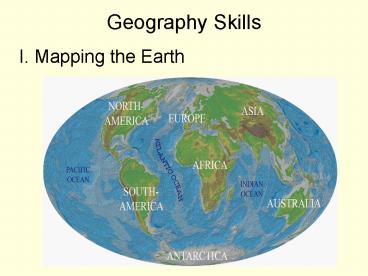Geography Skills - PowerPoint PPT Presentation
1 / 49
Title: Geography Skills
1
Geography Skills
- I. Mapping the Earth
2
Terms
- Globe a scale model of the earth
3
- Grid a pattern of lines that circle the earth in
an east-west and north-south direction
4
- Latitude
- Distance north or south of the equator
- Lines are called parallels
5
- Longitude
- Distance east and
- west of the
- Prime Meridian
- Lines are called
- meridians
6
- Equator
- 0 degrees latitude - halfway between
- the North and South Poles
7
- Prime Meridian
- 0 degrees longitude, passes through
- Greenwich, England
8
- Degrees are a measure of distance
- 60 minutes in a degree
- 60 seconds in a minute
Example 3637'00"N 0872622"W
9
- Hemispheres
Western and Eastern
Map of the World, 1597
Northern and southern
map dated 1/1/1790
10
- Continents
- The seven large landmasses on Earth
11
- Oceans
- The four largest bodies of water
12
- What are the seven seas?
- To the ancients, "seven" often meant "many," and
before - the fifteenth century, the many seas of the world
were - the Red Sea
- the Mediterranean Sea
- the Persian Gulf
- the Black Sea
- the Adriatic Sea
- the Caspian Sea
- the Indian Ocean
13
II. Mapmaking
14
- Map flat diagram of all or part of the earths
surface
15
- Atlas organized collection of maps in one book
16
- Map Projections
- different ways of showing the round world on
flat maps
17
- Map Projections
- Three types are cylindrical, conic, flat-plane
18
- The Robinson Projection is often used for world
maps
19
- Great-circle route The shortest route between
any two points on the planet
20
III. Map Essentials
21
- Terms
- Legend or Key explain what the symbols on a
map represent
22
- Compass Rose arrows point in the cardinal
directions
23
- Scales represent distances between points on a
map
24
- Inset maps show a small part of a larger map
25
IV. Working with maps
26
- Physical-political
- maps
- show important
- physical and
- political features
27
- Climate Maps show dominant weather patterns in a
certain area
28
- Population maps show where people live and the
population density
29
- Economic maps show important resources and
activities of an area
30
V. Using Graphs and Diagrams
31
- Bar graph visual way to present information
32
- Pie graph shows how a whole is divided into
parts
33
- Line graphs used to show trends, comparisons,
and size
34
- Climograph compares temperature and
precipitation in different locations
35
- Age structure diagrams percentage of males and
females by age group in a particular area
36
- Tables provide statistical information
37
- Charts group information together by category,
class, family
38
- Timelines Provide highlights of important
events over a period of time
39
- Flowcharts explain different processes, leading
from one step to the next
40
- Graphic organizers Aid in understanding certain
ideas and concepts
41
- Time-Zone maps reflect the difference in the
suns position over various areas on earth
42
- International Date Line located at 180 degrees
longitude, 12 hours difference from Greenwich
43
VI. Thinking critically and writing
- Thinking critically evaluating, analyzing or
interpreting information from a source
44
VI. Thinking critically and writing
- Purposes for writing express, inform,
- classify, persuade, compare/contrast
45
VI. Thinking critically and writing
- The 5-step writing process
- 1. Prewriting thinking about and planning what
to write
46
The 5-step writing process
- 2. Writing the Draft
- Topic sentence states main idea
- Body develops and supports main idea
- Conclusion summarizes main points or restates
main idea
47
The 5-step writing process
- 3. Evaluating and revising what you
- have written
48
The 5-step writing process
- 4. Proofreading check for mistakes
49
The 5-step writing process
- 5. Write the final version
- Read the final version
- Share the final version































